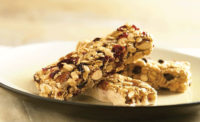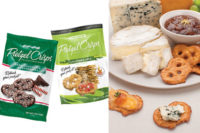Baked goods and snack foods made with whole grains and ancient grains, such as amaranth, oats, quinoa and spelt, used to be sold primarily in specialty natural and organic food stores, healthfood stores and in mom-and-pop stores catering to local ethnic groups. Now, products containing such grains are starting to appear more readily in bakery departments and bread aisles throughout the United States.
Why? Because consumer demand for better-for-you products is growing and Americans are more health-conscious—by choice or necessity. Thus, they’re more selective of the foods they buy. Federal dietary guidelines, informational websites and other readily accessible resources are helping educate people more about nutritional needs.
“Consumers are listening and increasingly taking a more proactive approach to their well-being to address concerns related to obesity, diabetes and overall wellness,” says Dilek Uzunalioglu, senior associate, applications, at Bridgewater, N.J.-based National Starch, a subsidiary of Corn Products International.
Bakers, snack manufacturers and their suppliers are taking note of consumers’ desire to eat better and know more about their foods, and are improving their products and labeling accordingly. “The recommendation that consumers should make at least half of [their] daily grain foods intake whole grain, as outlined in the [U.S. Department of Agriculture’s] Dietary Guidelines for Americans, 2010 report, continues to have an influence on product development and media,” says Dr. Elizabeth Arndt, director of research and development at ConAgra Mills, Omaha, Neb. “Our research shows the use of ‘whole grain’ or ‘whole wheat’ as a product descriptor adds or maintains purchase and taste appeal. In the retail segment, sales of breads described as whole wheat, multigrain or whole grain are increasing, while white bread sales are declining,” Arndt adds.
But health and wellness aren’t the only trends fueling demand. As the world becomes smaller, people are discovering tasty and nutritious grain-based foods from other countries and incorporating them into their diets.
“Ancient grains have ‘Old World appeal’ with unique tastes and textures,” says Colleen Zammer, director of product marketing at Bay State Milling Co., Quincy, Mass. “There are now a measurable number of people buying quinoa today, which tells a story within itself.”
Grain go-tos
Bakers and snack manufacturers ready to introduce products made with ancient and whole grains to their lineups find they have plenty of varieties from which to choose, including: Amaranth, barley, flaxseed, kamut, millet, oats, quinoa, rye, sorghum, spelt, teff, whole wheat,white whole wheat and whole corn.
Besides adding unique flavors, textures and mouthfeel to baked goods and snacks, many of these grains also are rich in protein, antioxidants, Omega-3 fatty acids and other beneficial nutrients and gluten-free, more attributes important to health-conscious consumers. Interested bakers and snack producers also are discovering that whole and ancient grains are readily available from a variety of leading suppliers.
ConAgra Mills offers a comprehensive line of whole-grain ingredients that includes Ultragrain whole-wheat flour and Sustagrain high-fiber barley and rye, as well as ancient grains such as amaranth, quinoa, millet, sorghum and teff.
The ancient grains are available as individual whole-grain flours and seeds, in standard and custom multigrain blends. They also are key components in ConAgra Mills’ Eagle Mills Gluten-Free All-Purpose Multigrain Flour and currently being used in numerous grain-based foods on the market, such as breads, tortillas, crackers and bars.
In terms of ancient grains, “we pretty much hit them all,” says Ken Ruud, sales lead for value-added products at Horizon Milling, a leading U.S. flour miller and a joint venture between Cargill Inc. and CHS Inc., a cooperative owned by farmers, ranchers and co-ops across the United States. “We do everything from quinoa, spelt and amaranth to buckwheat, millet, barley and rye. We offer these in individual, whole-grain blends and in very particular blends.”
Horizon Milling’s whole-grain offerings include whole-wheat flour, WheatSelect white spring whole-wheat flour and MaizeWise whole-grain corn flour. Applications range from breads and rolls to cereals and bars.
National Starch also offers a whole-grain corn flour. Made from high-amylose corn, Hi-maize contains resistant starch, a naturally occurring form of dietary fiber shown to provide digestive and health benefits, including glycemic and blood sugar management. According to Uzunalioglu, Hi-maize is suitable for flaked and extruded ready-to-eat cereals, breads, rolls, cookies and other baked goods.
White whole-wheat flour, whole-wheat flour and custom multigrain mixes containing whole-and ancient grains are just some of the products offered by Thymly Products Inc., Colora, Md. “We use lots of different grains [in our mixes],” says purchasing agent Vince Reynolds. “We use amaranth, quinoa, sorghum and spelt, as well as flaxseed and chia.” The majority of the company’s grains find their way into breads and specialty chips, such as corn, tortilla and multigrain chips.
Bay State Milling also offers a range of grains and formats for use in all grain-based foods, according to Zammer. “We specialize in wheat, rye, spelt, triticale and barley, and we can mill these into whole-grain flour or we can cut, crack or flake these grains,” she explains.
Bay State can blend any and all of these grains with other grains. Zammer says such blends have been applied in most grain based-foods, from breads and pizza crusts to pancake mixes, and are used as inclusions and topical additions.
Chilton, Wis.-based Briess Malt & Ingredients Co. uses heat, water and time to produce value-added whole grains used to enhance foods, from baked goods and bars to breakfast cereals and snacks. Ingredients include malted barley flours, roasted grains and pre-gelatinized grains. “Because they have been only minimally processed, they retain the healthy integrity of the raw whole grain,” says technical services representative Judie Giebel.
The company’s CocoaPlus cocoa replacers are made from whole-grain malted barley and malted wheat that have been specially roasted and processed to mimic a natural cocoa. “The functionality is the same as cocoa,” Giebel explains. “Substitution rates are as high as 50% in some baked applications.”
Under development
Despite growing interest in products made with whole grains and ancient grains, and the ready availability of these ingredients, breads and cereals still dominate this category. “Whole grains comprise only 8% of snack and granola bars, 7% of dry pasta, 2% of pancake mixes and less than 0.4% of other types of baking mixes,” says Arndt. “The good news is that whole-grain product offerings are showing strong growth, while the sales of their refined grain counterparts are flat to negative.”
Keeping up with dietary guidance, nutrition research and food regulations, as well as with new ingredients and technologies being used to produce grain-based foods, enables ConAgra Mills to meet customers’ needs. The company also sponsors health-related research using foods made with its whole-grain ingredients.
“We’re about customization with our blends and product development,” says Ruud, explaining that Horizon Milling looks closely at a wholesale bakery’s portfolio to determine who its customers are. Ruud recalls Horizon Milling’s recent partnership with Safeway Inc., which resulted in the launch, last January, of Safeway’s line of all-natural, whole-grain breads made with various ancient grains. “Ancient grains was a void in the company’s portfolio,” he explains. “We saw that there was an opportunity for Safeway to fill that gap in its private-label portfolio with great-tasting products.”
National Starch collaborates with manufacturers to help them determine what type of fiber or whole grain claims they want to make in a product, its texture target, its shelf life requirement and more, says Uzunalioglu. “We then work with them to formulate target products using Hi-maize whole grains to deliver a product with whole-grain benefits, but with no compromise in texture and taste,” he explains. “We also provide access to our broad library of Hi-maize whole-grain corn flour formulas.”
Bay State Milling, meanwhile, invites clients to work with food scientists, bakers and culinologists at its Rothwell GrainEssentials Center to create new product concepts that can be quickly scaled to market. “Our center is a means to teach our customers how to work with our products and to bring market insight and commercial baking experience to the development process,” Zammer says.
Briess Malt & Ingredients Co.’s flexibility and small-batch production capabilities enable it to work closely with manufacturers to develop custom products that meet their specifications.
Thymly Products also works closely with clients to formulate grain mixes that meet their needs. Says Regional Sales Manager Trey Muller-Thym, “Basically, they’re coming to us and saying, ‘We want to have ancient grains. We want to make these [ingredient changes]. Can you put a mix together that’s going to help us meet our requirements?’”
Get a (shelf) life
Working closely with knowledgeable grain suppliers when creativng new products also enables bakers and snack manufacturers to address important issues, such as shelf life and allergens, says Zammer. Bay State Milling works closely with other ingredient suppliers in the industry to stay abreast of trends and technologies in enzymes, dough conditioners, preservatives, natural and organic alternatives and more. “We will use these ingredients to prove a concept that we develop and will provide that information to the customer for their own use, as they scale up a formula,” Zammer explains.
Because Briess Malt & Ingredients Co. processes its grains only minimally and uses no preservatives or additives to maintain their natural integrity. Giebel says the company spends a great deal of time analyzing its processing procedures and storage to extend shelf life, and educating its customers on proper storage and handling. The company follows strict changeover and handling practices—from receiving to shipping—to deal with allergens.
Christine Cerkvenik, dry corn ingredients commercial manager at Cargill, says the company addresses shelf life in its MaizeWise corn flour during processing. “Inherently, when you have a grain and you’re going to mill it, there are unstable parts that include oils that can cause rancidity in products,” she explains. “For our whole-grain corn flour, we have a proprietary process where we stabilize the unstable portion of the corn and are able to have an adequate shelf life formulation.”
National Starch exposes its Hi-maize whole-grain corn flour to a controlled amount of heat before grinding to extend its shelf life, says Uzunalioglu. The company also provides recommendations on specialty starches to help with moisture management in the product, further improving its shelf life.
Whole-grain challenges
As with other product categories experiencing steady growth, availability and price will likely impact whole and ancient grain suppliers, users and consumers as demand for these ingredients increases. “The number of customer inquiries for rare and ancient grains is growing and just keeping up with new requests is a challenge,” says Giebel. “But the bigger challenge is sourcing these grains, and pricing is often a barrier for using them, especially for smaller manufacturers.”
Bakers and snack manufacturers may observe that whole-grain and ancient grains formulations, which often have different use requirements than refined grains. “When formulating with whole grains, manufacturers typically need to adjust formulations, as whole grains have a higher water absorption than refined grains,” explains Uzunalioglu. “Manufacturers should also adjust mixing and baking time to achieve the desired texture and color. The biggest challenge is to minimize the impact on taste, texture, appearance and processing. The goal is to deliver products similar in flavor and texture to those manufactured with refined grains with minimal impact on processing conditions and equipment.”
Bay State’s Zammer agrees that whole-grain dough may absorb more water, but she says it does so more slowly, requiring manufacturers to adjust their water addition and mixing time and speed.
Hi-maize whole-grain corn flour, on the other hand, has lower water absorption compared to most whole-grain flours on the market, according to Uzunalioglu, making it easier to incorporate into formulations with minimal adjustments. SF&WB












